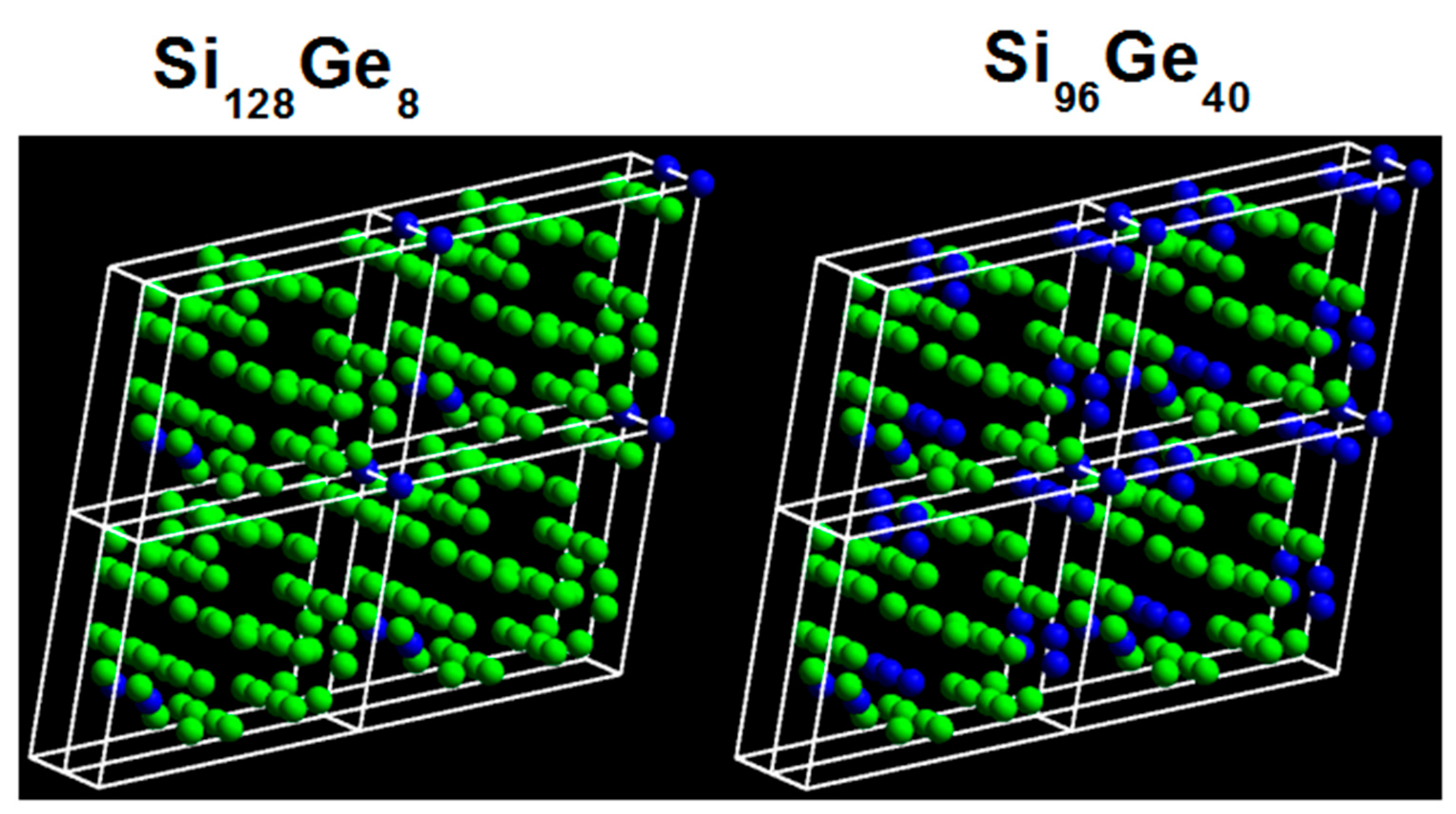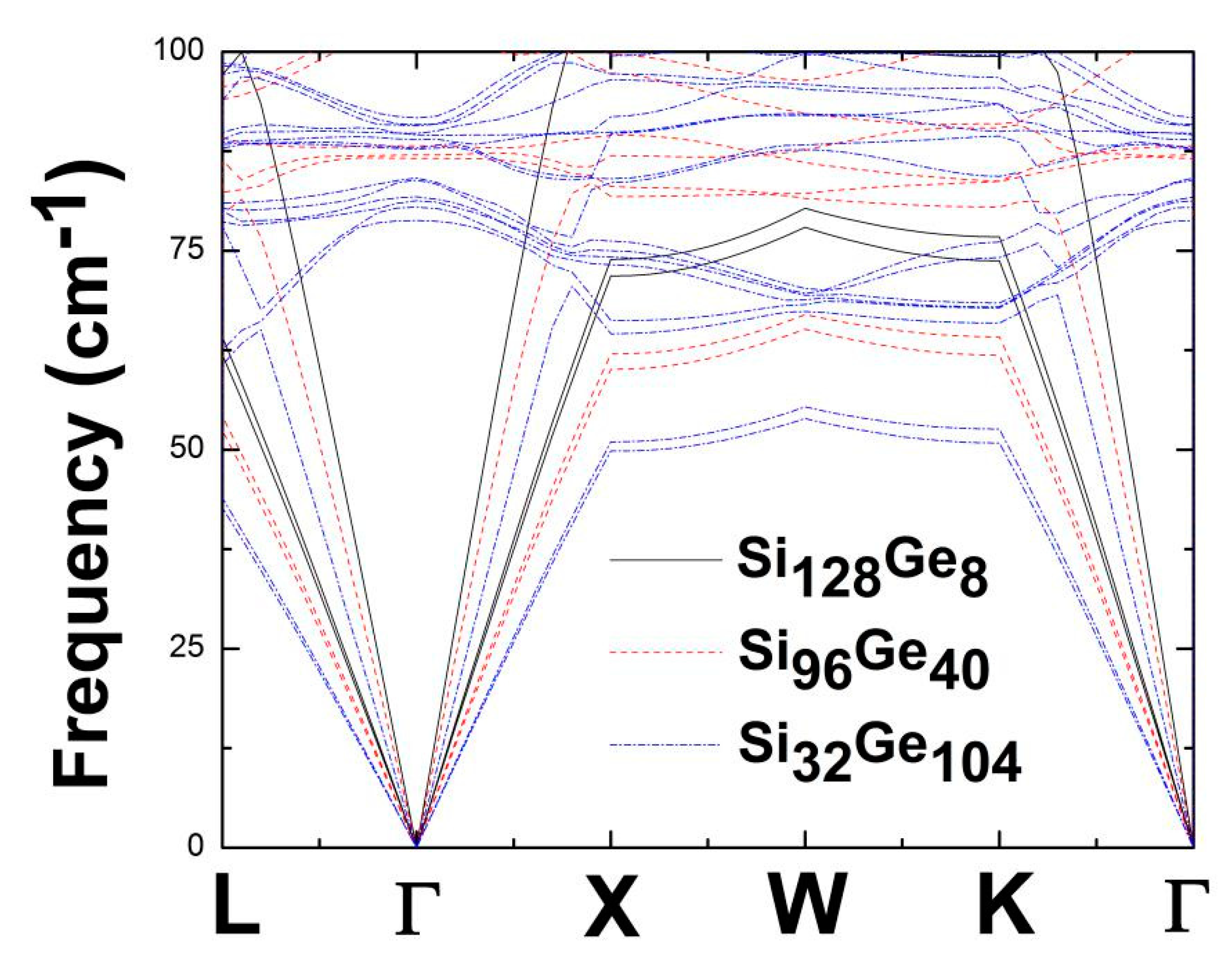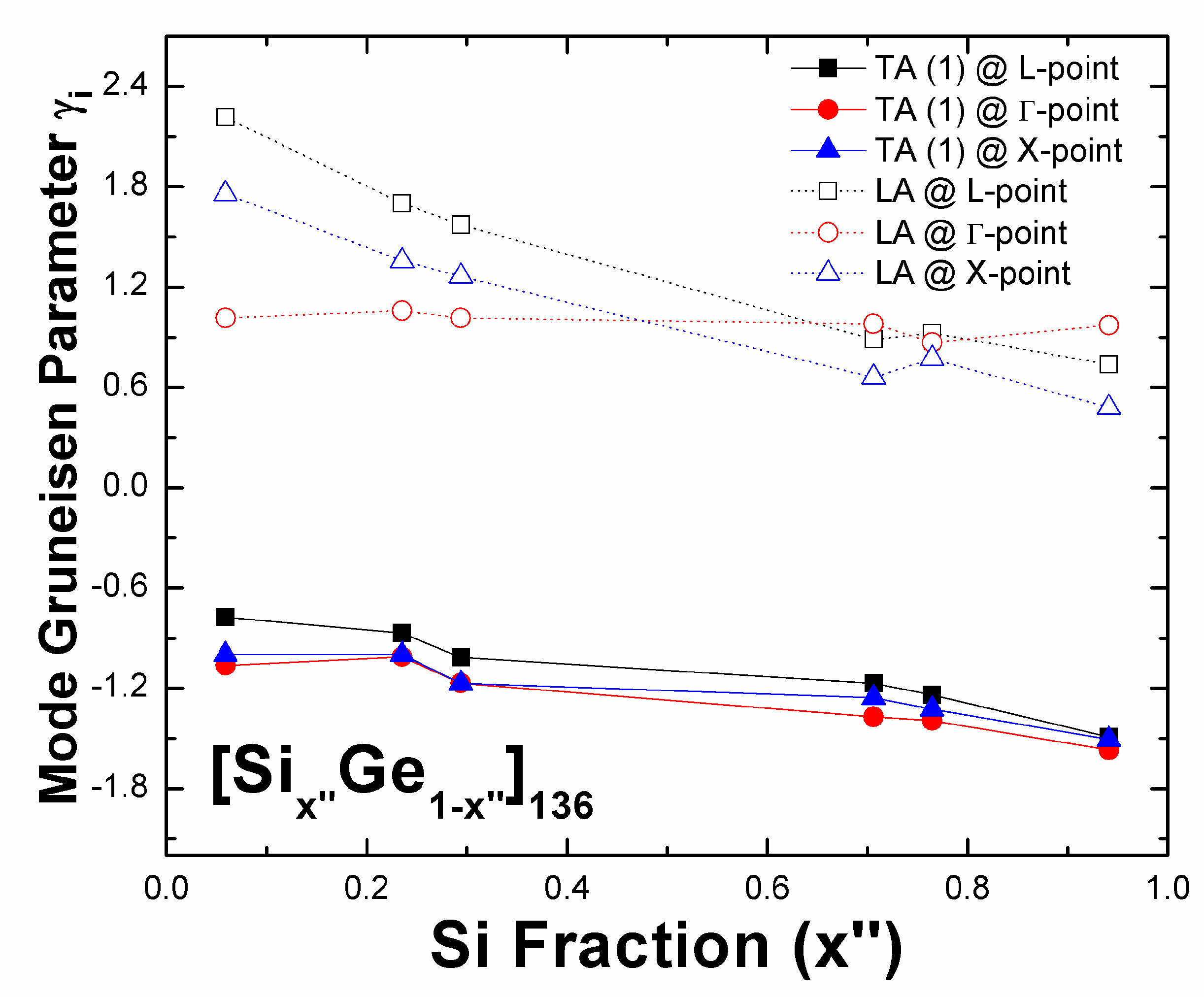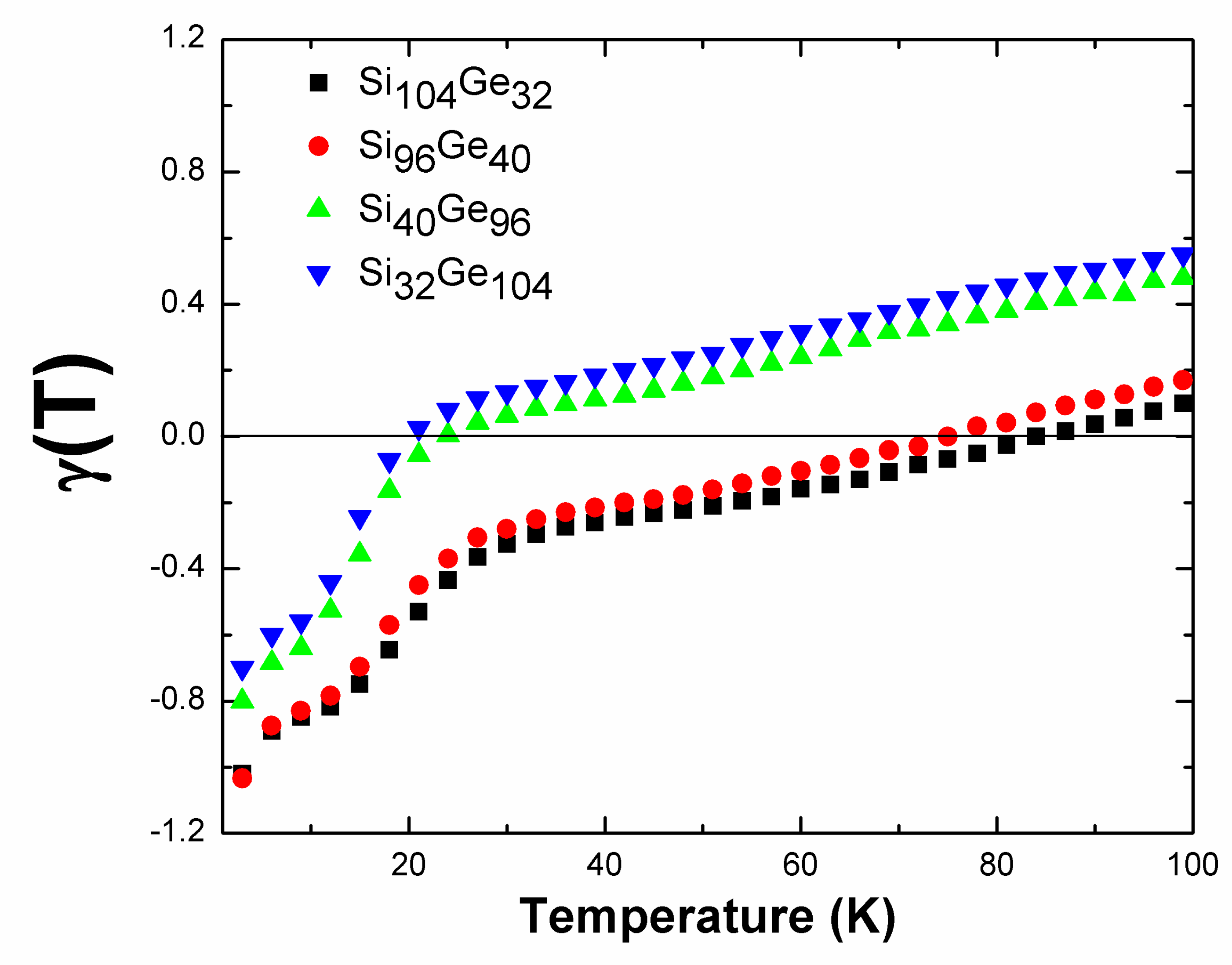First-Principles Analysis of Vibrational Properties of Type II SiGe Alloy Clathrates
Abstract
:1. Introduction
2. Computational Approach
3. Results and Discussion
3.1. Electronic Properties
3.2. Vibrational Properties
4. Conclusions
Author Contributions
Funding
Acknowledgments
Conflicts of Interest
References
- Biswas, K.; Myles, C.W. Electronic structure of the Na16Rb8Si136 and K16Rb8Si136 clathrates. Phys. Rev. B 2006, 74, 115113. [Google Scholar] [CrossRef]
- Kawaji, H.; Horie, H.; Yamanaka, S.; Ishikawa, M. Superconductivity in the Silicon Clathrate Compound (Na,Ba)xSi46. Phys. Rev. Lett. 1995, 74, 1427. [Google Scholar] [CrossRef] [PubMed]
- Yamanaka, S.; Horie, H.; Kawaji, H.; Ishikawa, M. Preparation and Superconductivity of Barium Containing Silicon Clathrate Compound, (Ba, K)xSi46. ChemInform 1996, 27. [Google Scholar] [CrossRef]
- Kawaji, H.; Iwai, K.; Yamanaka, S.; Ishikawa, M. Composition dependence of the superconducting transition temperature of silicon clathrate compound NaxBa6Si46. Solid State Commun. 1996, 100, 393. [Google Scholar] [CrossRef]
- Yamanaka, S.; Enishi, E.; Fukuoka, H.; Yasukawa, M. High-Pressure Synthesis of a New Silicon Clathrate Superconductor, Ba8Si46. Inorg. Chem. 2000, 39, 56. [Google Scholar] [PubMed]
- Suekuni, K.; Avila, M.A.; Umeo, K.; Takabatake, T. Cage-size control of guest vibration and thermal conductivity in Sr8Ga16Si30-xGex. Phys. Rev. B 2007, 75, 195210. [Google Scholar] [CrossRef]
- Nakagawa, N.; Miyake, M.; Hayase, H.; Koyanagi, T. Thermoelectric Conversion Symposium Proceeding; Tokyo, Japan, 2002; pp. 136–137. [Google Scholar]
- Martin, J.; Erickson, S.; Nolas, G.S.; Alboni, P.; Tritt, T.M.; Yang, J. Structural and transport properties of Ba8Ga16SixGe30-x clathrates. J. Appl. Phys. 2006, 99, 044903. [Google Scholar] [CrossRef]
- Chen, G. Thermal conductivity and ballistic-phonon transport in the cross-plane direction of superlattices. Phys. Rev. B 1998, 57, 14958. [Google Scholar] [CrossRef]
- Ioffe, A.F. Thermoelements and Thermoelectric Cooling; Infosearch Limited: London, UK, 1957. [Google Scholar]
- Myles, C.W.; Dong, J.; Sankey, O.F. Rattling Guest Atoms in Si, Ge and Sn-based Type II Clathrate Materials. Phys. Status Solidi B 2003, 239, 26. [Google Scholar]
- Mano, S.; Onimaru, T.; Yamanaka, S.; Takabatake, T. Off-center rattling and thermoelectric properties of type-II clathrate (K, Ba)24(Ga, Sn, ☐)136 single crystals. Phys. Rev. B 2011, 84, 214101. [Google Scholar] [CrossRef]
- Nolas, G.S.; Kendziora, C.A.; Gryko, J.; Dong, J.; Myles, C.W.; Poddar, A.; Sankey, O.F. Raman scattering study of stoichiometric Si and Ge type II clathrates. J. Appl. Phys. 2002, 92, 7225. [Google Scholar] [CrossRef]
- Nolas, G.S.; Vanderveer, D.G.; Wilkinson, A.P.; Cohn, J.L. Temperature dependent structural and transport properties of the type II clathrate A8Na16E136 (A = Cs or Rb and E = Ge or Si). J. Appl. Phys. 2002, 91, 8970. [Google Scholar] [CrossRef]
- Tse, J.S.; Uehara, K.; Rousseau, R.; Ker, A.; Ratcliffe, C.I.; White, M.A.; Mackay, G. Structural principles and amorphuslike thermal conductivity of Na-doped Si clathrates. Phys. Rev. Lett. 2001, 86, 4980. [Google Scholar] [CrossRef]
- Beekman, M.; Wong-Ng, W.; Kaduk, J.A.; Shapiro, A.; Nolas, G.S. Synthesis and single-crystal X-ray diffraction studies of new framework substituted type II clathrates, Cs8Na16AgxGe136-x (x<7). J. Solid State Chem. 2007, 180, 1076. [Google Scholar] [CrossRef]
- Gryko, J.; Marzke, R.F.; Lamberton, G.A.; Tritt, T.M.; Beekman, M.; Nolas, G.S. Electron structure and temperature-dependent shifts in 133Cs NMR spectra of the Cs8Ge136 clathrate. Phys. Rev. B. 2005, 71, 115208. [Google Scholar] [CrossRef]
- Nolas, G.S.; Slack, G.A.; Morelli, D.T.; Tritt, T.M.; Ehrlich, A.C. The effect of rare-earth filling on the lattice thermal conductivity of skutterudites. J. Appl. Phys. 1996, 79, 4002. [Google Scholar] [CrossRef]
- Nolas, G.S.; Kendziore, C.A. Raman scattering study of Ge and Sn compounds with type-I clathrate hydrate crystal structure. Phys. Rev. B 2000, 62, 7157. [Google Scholar] [CrossRef]
- Slack, G.A. CRC Handbook of Thermoelectrics; Rowe, D.M., Ed.; CRC: Boca Raton, FL, USA, 1995; pp. 407–440. [Google Scholar]
- Slack, G.A. Proceedings of Thermoelectric Materials: New Directions and Approaches; MRS Symposia Proceedings No. 478; Materials Research Society: Pittsburgh, PA, USA, 1997; p. 47. [Google Scholar]
- Biswas, K.; Myles, C.W. Electronic and vibrational properties of framework-substituted type-II silicon clathrates. Phys. Rev. B 2007, 75, 245205. [Google Scholar] [CrossRef]
- Nenghabi, E.N.; Myles, C.W. First-principles calculations of the vibrational and thermal properties of the type-I clathrates Ba8Ga16SixGe30-x and Sr8Ga16SixGe30-x. Phys. Rev. B 2008, 78, 195202. [Google Scholar] [CrossRef]
- Tang, X.; Dong, J.; Hutchins, P.; Shebanova, O.; Gryko, J.; Barnes, P.; Cockcroft, J.K.; Vickers, M.; McMillan, P.F. Thermal properties of Si136: Theoretical and experimental study of the type-II clathrate polymorph of Si. Phys. Rev. B 2006, 74, 014109. [Google Scholar] [CrossRef]
- Nolas, G.S.; Beekman, M.; Gryko, J.; Lamberton, G.A., Jr.; Tritt, T.M.; McMillan, P.F. Thermal conductivity of elemental crystalline silicon clathrate Si136. App. Phys. Lett. 2003, 82, 910. [Google Scholar] [CrossRef]
- Beekman, M.; Kaduk, J.A.; Wong-Ng, W.; Troesch, M.; Lee, G.S.; Nolas, G.S. Control of thermal expansion in a low-density framework modification of silicon. App. Phys. Lett. 2018, 112, 181901. [Google Scholar] [CrossRef]
- Martinez, A.D.; Krishna, L.; Baranowski, L.L.; Lusk, M.T.; Toberer, E.S.; Tamboli, A.C. Synthesis of Group IV clathrates for photovoltaics. IEEE J. Photovolt. 2013, 4, 1305. [Google Scholar] [CrossRef]
- Zhao, J.; Buldum, A.; Lu, J.; Fong, C.Y. Structural and electronic properties of germanium clathrates Ge46 and K8Ge46. Phys. Rev. B 1999, 60, 14177. [Google Scholar] [CrossRef]
- Nolas, G.S.; Cohn, J.L.; Slack, G.A.; Schujman, S.B. Semiconducting Ge clathrates: Promising candidates for thermoelectric applications. Appl. Phys. Lett. 1998, 73, 178. [Google Scholar] [CrossRef]
- Herrmann, R.F.W.; Tanigaki, K.; Kawaguchi, T.; Kuroshima, S.; Zhou, O. Electric structure of Si and Ge gold-doped clathrates. Phys. Rev. B 1999, 60, 13245. [Google Scholar] [CrossRef]
- Moriguchi, K.; Munetoh, S.; Shintani, A. First-principles study of Si34-xGex clathrates: Direct wide-gap semiconductors in Si-Ge alloys. Phys. Rev. B 2000, 62, 7138. [Google Scholar] [CrossRef]
- Harkonen, V.J.; Karttunen, A.J. Ab initio lattice dynamical studies of silicon clathrate frameworks and their negative thermal expansion. Phys. Rev. B 2014, 89, 024305. [Google Scholar] [CrossRef]
- Harkonen, V.J.; Karttunen, A.J. Ab initio studies on the lattice thermal conductivity of silicon clathrate framework II and VIII. Phys. Rev. B 2016, 93, 024307. [Google Scholar] [CrossRef]
- Falenty, A.; Hansen, T.C.; Kuhs, W.F. Formation and properties of ice XVI obtained by emptying a typr sII clathrate hydrate. Nature 2014, 516, 231. [Google Scholar] [CrossRef]
- Guyot, Y.; Grosvalet, L.; Champagnon, B.; Reny, E.; Cros, C.; Pouchard, M. Grüneisen parameters for silicon clathrates determined by Raman scattering. Phys. Rev. B 1999, 60, 14507. [Google Scholar] [CrossRef]
- Weinstein, A.; Zallen, R. Light Scattering in Solids IV; Topics in Applied Physics; Springer: Berlin, Germany, 1984; Volume 54. [Google Scholar]
- Baranowski, L.L.; Krishna, L.; Martinez, A.D.; Raharjo, T.; Stevanovic, V.; Tamboli, A.C.; Toberer, E.S. Synthesis and optical band gaps of alloyed Si-Ge type II clathrates. J. Mater. Chem. C 2014, 2, 3231–3237. [Google Scholar] [CrossRef]
- Kresse, G.; Furthmuller, J. Efficient iterative schemes for ab initio total-energy calculations using a plane-wave basis set. Phys. Rev. B 1996, 54, 11169. [Google Scholar] [CrossRef]
- Monkhorst, H.J.; Pack, J.D. Special points for Brillouin-zone integrations. Phys. Rev. B 1976, 13, 5188. [Google Scholar] [CrossRef]
- Birch, F. Elasticity and constitution of the Earth’s interior. J. Geophys. Res. 1952, 57, 227. [Google Scholar] [CrossRef]
- Kasper, J.S.; Hagenmuller, P.; Pouchard, M.; Cros, C. Clathrate structure of silicon Na8Si46 and NaxSi136 (x<11). Science 1965, 150, 1713. [Google Scholar] [CrossRef]
- Perdew, J.P.; Levy, M. Physical content of the exact Kohn-Sham orbital energies: Band gaps and derivative discontinuities. Phys. Rev. Lett. 1983, 51, 1884. [Google Scholar] [CrossRef]
- Bechstedt, F.; Sole, R.D. Analytical treatment of band-gap underestimates in the local-density approximation. Phys. Rev. B 1988, 38, 7710. [Google Scholar] [CrossRef]
- Dong, J.; Sankey, O.F.; Ramachandran, G.K.; McMillan, P. Chemical trends of the rattling phonon modes in alloyed germanium clathrates. J. Appl. Phys. 2000, 87, 7726. [Google Scholar] [CrossRef]
- Biswas, K.; Myles, C.W.; Sanati, M.; Nolas, G.S. Thermal properties of guest-free Si136 and Ge136 clathrates: A first-principles study. J. Appl. Phys. 2008, 104, 033535. [Google Scholar] [CrossRef]
- Wei, S.; Li, C.; Chou, M.Y. Ab initio calculation of thermodynamic properties of silicon. Phys. Rev. B 1994, 50, 14587. [Google Scholar] [CrossRef]
- Roberts, R.W.; Ruppin, R. Volume dependence of the Grüneisen parameter of alkali halides. Phys. Rev. B 1971, 4, 6. [Google Scholar] [CrossRef]
- Barron, T.H.K.; Collins, J.G.; White, G.K. Thermal expansion of solids at low temperatures. Adv. Phys. 1980, 29, 609. [Google Scholar] [CrossRef]
- Barron, T.H.K. Grüneisen parameters for the equation of state of solids. Ann. Phys. 1957, 1, 77–90. [Google Scholar] [CrossRef]
- Liu, Y.; Wang, Z.; Wu, M.; Sun, Q.; Chao, M.; Jia, Y. Negative thermal expansion in isostructural cubic ReO3 and ScF3: A comparative study. Comput. Mater. Sci. 2015, 107, 157–162. [Google Scholar] [CrossRef]












| Material | L | X | W | K |
|---|---|---|---|---|
| Si128Ge8 | 61.89 | 71.81 | 77.93 | 73.72 |
| Si96Ge40 | 52.41 | 60.11 | 65.14 | 61.86 |
| Si32Ge104 | 42.74 | 49.84 | 53.90 | 50.84 |
| Material | Mode | L | Γ |
|---|---|---|---|
| Si8Ge128 | TA (1) | −0.76 | −1.04 |
| LA | 2.18 | 0.98 | |
| Si32Ge104 | TA (1) | −0.85 | −1.01 |
| LA | 1.68 | 1.03 | |
| Si96Ge40 | TA (1) | −1.16 | 1.32 |
| LA | 0.87 | 0.96 | |
| Si104Ge32 | TA (1) | −1.20 | −1.35 |
| LA | 0.90 | 0.90 | |
| Si128Ge8 | TA (1) | −1.43 | −1.51 |
| LA | 0.71 | 0.93 | |
| d-Si (Exp.) | TA (1) | −1.30 | 0.05 |
| LA | 0.90 | 1.10 | |
| Na1Si136 | TA (1) | ----- | 1.18 |
© 2019 by the authors. Licensee MDPI, Basel, Switzerland. This article is an open access article distributed under the terms and conditions of the Creative Commons Attribution (CC BY) license (http://creativecommons.org/licenses/by/4.0/).
Share and Cite
Xue, D.; Myles, C.W. First-Principles Analysis of Vibrational Properties of Type II SiGe Alloy Clathrates. Nanomaterials 2019, 9, 723. https://doi.org/10.3390/nano9050723
Xue D, Myles CW. First-Principles Analysis of Vibrational Properties of Type II SiGe Alloy Clathrates. Nanomaterials. 2019; 9(5):723. https://doi.org/10.3390/nano9050723
Chicago/Turabian StyleXue, Dong, and Charles W. Myles. 2019. "First-Principles Analysis of Vibrational Properties of Type II SiGe Alloy Clathrates" Nanomaterials 9, no. 5: 723. https://doi.org/10.3390/nano9050723
APA StyleXue, D., & Myles, C. W. (2019). First-Principles Analysis of Vibrational Properties of Type II SiGe Alloy Clathrates. Nanomaterials, 9(5), 723. https://doi.org/10.3390/nano9050723





